Author:
Marcus Baldwin
Date Of Creation:
18 June 2021
Update Date:
22 June 2024

Content
- Steps
- Part 1 of 4: Preparing the area for the terrace
- Part 2 of 4: Preparing the foundation
- Part 3 of 4: Installing the formwork
- Part 4 of 4: Pouring the concrete
- Tips
- Warnings
- What do you need
- Additional articles
A terrace is a great addition to any home, but homeowners usually have to weigh the benefits of their own terrace on one side of the scale and the cost of the builders on the other. To save on contractor fees, consider making your own concrete deck.
Steps
Part 1 of 4: Preparing the area for the terrace
 1 Determine where you want to build the terrace, how big it will be, what its exact dimensions will be. The amount of concrete required for its construction depends on the size of the terrace, and how you will mix the concrete - by hand or using a concrete mixer. If you are planning on making a terrace that is too large, you may find it difficult to manage on your own. The location of the terrace is also important. You need to select an area that is almost level so as not to level it before pouring the concrete.
1 Determine where you want to build the terrace, how big it will be, what its exact dimensions will be. The amount of concrete required for its construction depends on the size of the terrace, and how you will mix the concrete - by hand or using a concrete mixer. If you are planning on making a terrace that is too large, you may find it difficult to manage on your own. The location of the terrace is also important. You need to select an area that is almost level so as not to level it before pouring the concrete. - Check the SNIPs at what distance the terrace should be located from the residential building.
- Before digging the ground on the territory, find out how the sewer pipe, electrical wiring, wires and other communications are laid.
 2 Drive the pegs into the corners of the future terrace. Pull the rope between the pegs, use the building level to determine the slope. The pegs and rope will give you an idea of how much space the terrace will take up in your yard. If necessary, correct the boundaries of the future terrace.
2 Drive the pegs into the corners of the future terrace. Pull the rope between the pegs, use the building level to determine the slope. The pegs and rope will give you an idea of how much space the terrace will take up in your yard. If necessary, correct the boundaries of the future terrace. - Sharpen the pegs by trimming them at one end. This will make it easier for you to drive them into the ground.
- If the ground on your site is uneven, you have two exits: either build on the lower part to the level of the higher one, or tear down the higher part to the level of the lower one.
 3 In the fenced area, remove weeds, grass roots and topsoil. This can be done with a shovel, hoe, or other gardening equipment.
3 In the fenced area, remove weeds, grass roots and topsoil. This can be done with a shovel, hoe, or other gardening equipment.
Part 2 of 4: Preparing the foundation
 1 Decide if your deck will be level with the ground or raised. For a raised terrace, the excavation depth should be 10 cm, for a flat terrace - 20 cm.
1 Decide if your deck will be level with the ground or raised. For a raised terrace, the excavation depth should be 10 cm, for a flat terrace - 20 cm. - Compact the ground if necessary.
- If you plan on placing heavy elements on your terrace, such as a brick barbecue oven, then you will need to start by pouring the concrete foundation for the terrace to give it more stability and strength.
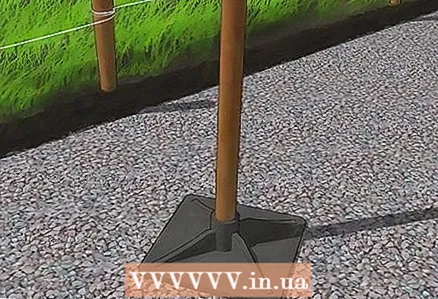 2 Spread a layer of gravel or crushed stone on the compacted soil. Usually the height of this layer is 10 cm.
2 Spread a layer of gravel or crushed stone on the compacted soil. Usually the height of this layer is 10 cm. - Check that the gravel or crushed stone is tamped down and laid in an even layer. The difference in the height of the base of the terrace can lead over time to vibrations and cracks in the concrete.
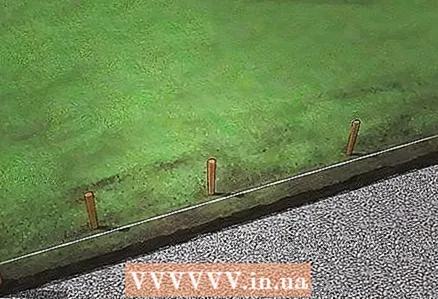 3 Drive stakes around the perimeter of your deck, at least 60 cm apart. These stakes should protrude slightly outside of the marking pegs. They will hold the deck formwork.
3 Drive stakes around the perimeter of your deck, at least 60 cm apart. These stakes should protrude slightly outside of the marking pegs. They will hold the deck formwork. - Make sure the stakes are driven deeply and securely into the ground.
- The terrace should be made with a slight slope so that rainwater can drain freely. The standard slope is approximately 3 mm for every 30.5 cm of area (or 1.5-2%). Check the SNIP (Building Codes and Rules) adopted in Russia.
- Don't underestimate the severity of the wet solution.Use very strong wood so that it doesn't buckle or crack under the weight of the mortar. To avoid such problems, steel formwork can be used.
Part 3 of 4: Installing the formwork
 1 Saw a 50 x 100 edged board for formwork. The formwork will hold the concrete, so the total length of the formwork planks must match the dimensions of your deck. After the concrete has set, you will remove the formwork, so consider the thickness of the board and subtract it from the size of the deck. If you ignore this thickness, your terrace may be smaller than you planned.
1 Saw a 50 x 100 edged board for formwork. The formwork will hold the concrete, so the total length of the formwork planks must match the dimensions of your deck. After the concrete has set, you will remove the formwork, so consider the thickness of the board and subtract it from the size of the deck. If you ignore this thickness, your terrace may be smaller than you planned.  2 Place the formwork planks along the rope that marks the edge of the terrace. The board should go strictly under the rope. Remember, 50 x 100 planks form the edge of the deck, so the inside of the plank should be under the rope in the correct place.
2 Place the formwork planks along the rope that marks the edge of the terrace. The board should go strictly under the rope. Remember, 50 x 100 planks form the edge of the deck, so the inside of the plank should be under the rope in the correct place.  3 Nail the 50 x 100 planks to the stakes. Stakes are needed so that the formwork is strong and does not bend under the weight of concrete. The nails should be long enough and strong enough.
3 Nail the 50 x 100 planks to the stakes. Stakes are needed so that the formwork is strong and does not bend under the weight of concrete. The nails should be long enough and strong enough. - You can use self-tapping screws instead of nails. In this case, you will need a screwdriver or screwdriver.
- When you nail the boards, make sure that the formwork is even, use a rope or a building level. If the formwork is multi-level, you end up with a curved terrace.
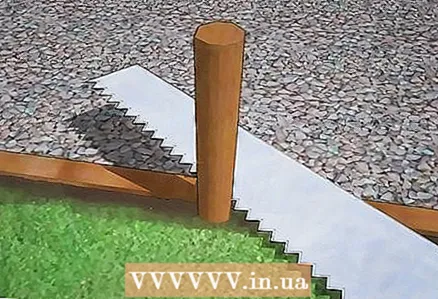 4 Saw off the top of the stakes. The stakes should now be slightly below the formwork. They should not rise above the concrete.
4 Saw off the top of the stakes. The stakes should now be slightly below the formwork. They should not rise above the concrete. - If your terrace is directly adjacent to a house, another concrete slab, or some structure, insert an insulating material between the surface and the concrete. The insulating material will allow the concrete to move and minimize cracks. Such insulating materials, impregnated with low-melting petroleum bitumen (for example, roofing material), or waterproofing strips, are attached to the wall or surface to which the concrete will adhere. These materials are sold in hardware stores.
 5 Lubricate the formwork with vegetable oil or a ready-made release agent. This will prevent the concrete from sticking to the formwork and will also give the concrete slab a finished look after the formwork is removed.
5 Lubricate the formwork with vegetable oil or a ready-made release agent. This will prevent the concrete from sticking to the formwork and will also give the concrete slab a finished look after the formwork is removed.
Part 4 of 4: Pouring the concrete
 1 Knead the concrete. You can do this either by hand or with a concrete mixer. Always follow the instructions on the package, observe the indicated amount of water and the method of mixing.
1 Knead the concrete. You can do this either by hand or with a concrete mixer. Always follow the instructions on the package, observe the indicated amount of water and the method of mixing. - To calculate the number of bags of cement you will need for construction, calculate the volume of the terrace in cubic meters. Multiply the height, width and length of the deck and you will find how many bags of cement you need. You can also use a similar calculator to calculate the amount of concrete.
- If you are mixing the mortar by hand, you can do it in a concrete trough or wheelbarrow. Knead the concrete with a shovel or hoe. Remember to wear construction gloves and safety goggles.
- If you are using a concrete mixer, make sure you can position it close enough to where you are making your deck. Do this before you start working on your project.
- The amount of concrete needed for your project will dictate whether you are mixing the concrete by hand or using a concrete mixer.
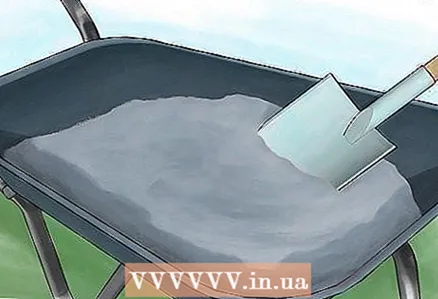 2 Pour concrete. Do this in one go to avoid displacement and subsidence of the independent slabs.
2 Pour concrete. Do this in one go to avoid displacement and subsidence of the independent slabs. - If you are using a cart, make a ramp to help you pour the concrete. Make sure the ramp does not wobble or touch the formwork. The ramp can be made from 50 x 100 long planks.
- At this stage, you may need an assistant. He can scoop concrete from the wheelbarrow while you hold it.
 3 Spread the solution to all corners with a shovel. The concrete is heavy, so get it as close to where you are working as possible. If you are pouring concrete over a large area, you will need long-handled tools to spread the concrete evenly.You can also wear rubber boots to walk straight on the concrete, spreading it across the area.
3 Spread the solution to all corners with a shovel. The concrete is heavy, so get it as close to where you are working as possible. If you are pouring concrete over a large area, you will need long-handled tools to spread the concrete evenly.You can also wear rubber boots to walk straight on the concrete, spreading it across the area.  4 Take a piece of plank (such as a 50 x 100 long plank) or aluminum batten (or a right if you have one) to level the top layer of concrete. Move from one end of the deck to the other, leveling the concrete with a sawing motion.
4 Take a piece of plank (such as a 50 x 100 long plank) or aluminum batten (or a right if you have one) to level the top layer of concrete. Move from one end of the deck to the other, leveling the concrete with a sawing motion. - The easiest way to do this is with an assistant.
 5 Take a long stick with a board attached to it to level the concrete surface. Move this tool back and forth to fill in gaps, depressions, and irregularities.
5 Take a long stick with a board attached to it to level the concrete surface. Move this tool back and forth to fill in gaps, depressions, and irregularities. - Water will seep up and protrude onto the concrete surface. Wait until the water is dry, then you can complete the construction of the terrace.
 6 Make the finishing touches. Using a long stick with a board attached to the end, level the surface of the concrete and round off the edges. When the concrete has hardened enough to support your weight, mark the concrete every 2.5 meters. Check marks will help you track over time whether unwanted changes are occurring to the concrete. The last step is to level the surface with a trowel.
6 Make the finishing touches. Using a long stick with a board attached to the end, level the surface of the concrete and round off the edges. When the concrete has hardened enough to support your weight, mark the concrete every 2.5 meters. Check marks will help you track over time whether unwanted changes are occurring to the concrete. The last step is to level the surface with a trowel.  7 Let the concrete cure and stand for at least two days. Cover the concrete with plastic wrap to prevent premature drying. After the concrete has hardened, remove the formwork. Be careful not to chunk off a piece of fresh concrete slab when doing this.
7 Let the concrete cure and stand for at least two days. Cover the concrete with plastic wrap to prevent premature drying. After the concrete has hardened, remove the formwork. Be careful not to chunk off a piece of fresh concrete slab when doing this.
Tips
- If you live in cold or humid climates, then consider making concrete slabs with air pores. The porosity provides air pockets in the concrete. They are not visible externally, but due to their presence, concrete will not collapse when moisture freezes.
- Consider the weather in which you are pouring the concrete. The temperature and humidity of the air will influence the curing time of the concrete.
- To increase stability and reduce the likelihood of cracking, mesh or reinforcement can be installed before pouring the concrete.
Warnings
- Remember to install locks if the slab is over 3.6m in any direction. They should be a quarter of the thickness of the slab and be spaced at a distance that is 10 times the thickness of the lock. For example, for a slab with a height of 10 cm, you should use locks with a height of 2.5 cm and place them at a distance of 2.5 - 3.5 meters from each other.
- Working with concrete can be dangerous. Don't forget to wear work clothes when making your deck. A long-sleeved shirt and pants work best. Wear safety goggles and construction gloves.
What do you need
- Rope
- Shovel
- Hammer or drill
- Roulette
- Gravel or crushed stone
- Sturdy wooden stakes
- Edged board 50x100x600
- Steel formwork (optional)
- Cement
- Water
- Stick-on board for leveling concrete
- Steel trowel
- Edge planer or plane
- Garden wheelbarrow
- Fasteners (optional)
- Aluminum ties (optional)
Additional articles
 How to pour a concrete foundation
How to pour a concrete foundation  How to remove a jammed screw
How to remove a jammed screw  How to drill holes in concrete
How to drill holes in concrete  How to make a skateboard ramp
How to make a skateboard ramp 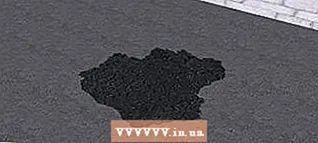 How to fill a hole in an asphalt road How to install (put) a wooden fence post
How to fill a hole in an asphalt road How to install (put) a wooden fence post 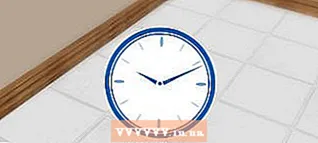 How to seal grout with sealant
How to seal grout with sealant  How to install piles in water for a dock or pier
How to install piles in water for a dock or pier 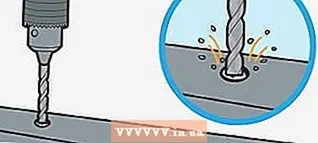 How to remove a broken screw
How to remove a broken screw 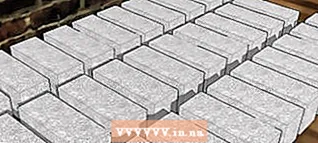 How to make concrete bricks
How to make concrete bricks  How to break concrete
How to break concrete 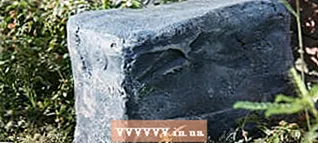 How to make artificial stones from concrete How to cut PVC pipes
How to make artificial stones from concrete How to cut PVC pipes  How to build a deck around an above ground pool
How to build a deck around an above ground pool



